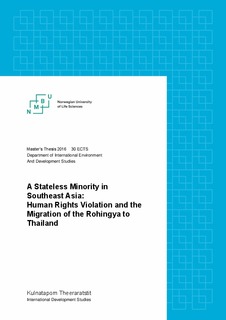| dc.description.abstract | Migration is not the new thing in the world today. The first wave of the migration happened as the aftermath of the World War I and the World War II. The existent of the Rohingya in Myanmar is considered as one of the results from British colonial rule. The Rohingyas are Muslims in Rakhine State in Myanmar who claimed that they have been living in the area for generations. Literally, the history of Muslims in Arakan could date back to the 15th century; however, the Muslims were called Chiitagonian or Bengali until the term “Rohingya” came into use for the first time in 1951 by a Muslim intellectual from Mayu Frontier Administration (MFA) in Rakhine State. The Muslim and Buddhist Arakanese have never been in a good relation since the ancient time. A remarkable crack of the relationship could be seen from the fight during the WWII. At that time, Muslims served the British as Vonlunteer force while Buddhist Arakanese supported the Japanese. They had no choice but fought each other which leaded to the later violence even after the war ended.
The beginning of the establishment of new states, Myanmar, Bangladesh, and Pakistan, allowed Rohingya to choose where they belong. However, they chose nothing. They expected to have their own territory from the British during the establishment process. Although the British did not give them land, the Rohingya succesfully lobbied U Nu, the first Prime Minister of Myanmar, that they only wanted the MFA which covers Maungdaw, Buthidaung, and the western part of Rathedaung. The MFA was still a part of the Union of Myanmar. Everything would fall into place if U Nu was not revolted by the General Ne Win in 1962. He revoked all compromising policies toward ethnic groups, the minority in Myanmar. Moreover, the Citizenship Law was enforced in 1982 to screen out aliens according to the consideration of the Burmese government.
The relationship between Muslim and Buddhist Arakanese in Rakhine was completely broken in 2012 when a Buddhist women was raped and murdered by three Muslims. The incident had become viral which led to the revenge by Buddhist Arakanese resulting in the death of 10 Muslims. Since then, the rights of the Rohingya has been violated and the discrimination in Rakhine State has become more and more severe which led to the migration of the Rohingya to Thailand | nb_NO |

